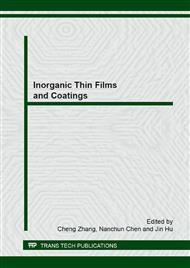[1]
M. Behpour, S.M. Ghoreishi, N. Mohammadi, et al., Investigation of some Schiff base compounds containing disulfide bond as HCl corrosion inhibitors for mild steel, Corr. Sci. 52 (2010) 4046.
DOI: 10.1016/j.corsci.2010.08.020
Google Scholar
[2]
A.B. da Silva, E. D'Elia, J.A. da Cunha Ponciano Gomes, Carbon steel corrosion inhibition in hydrochloric acid solution using a reduced Schiff base of ethylenediamine, Corr. Sci. 52 (2010) 788.
DOI: 10.1016/j.corsci.2009.10.038
Google Scholar
[3]
Q.Q. Liao, Z.W. Yue, D. Yang, et al., Self-assembled monolayer of ammonium pyrrolidine dithiocarbamate on copper detected using electrochemical methods, surface enhanced Raman scattering and quantum chemistry calculations, Thin Solid Films 519 (2011) 6492.
DOI: 10.1016/j.tsf.2011.04.240
Google Scholar
[4]
R.R. Annand, R.M. Hurd, Hackerma.N, Adsorption of monomeric and polymeric amino corrosion inhibitors on steel, J. Electrochem. Soc. 112 (1965) 138.
DOI: 10.1149/1.2423482
Google Scholar
[5]
S.L. Chen, Z. Liu, J. Liu, Synthesis, Characterization, Structure and quantum chemistry of the 4-((2-Thiophenecarboxylic acid hydrazide) methylene)benzoic acid, Chinese J. Appl. Chem. 2012.
DOI: 10.3724/sp.j.1095.2012.20018
Google Scholar
[6]
S.C. Shi, R.T. Fang, S.L. Tang, Study on corrosion inhibition performance of imidazoline phosphonoamide hydrochloride in simulated oilfield water, Oilfield Chemistry, 25 (2008) 34.
Google Scholar
[7]
C.W. Chai, G.A. Zhang, M.X. Lu, Electrochemical behavior and corrosion mechanism of X65 Steel in CO2-saturated oilfield water, Corrosion & Protection, 29 (2008) 54.
Google Scholar
[8]
J. Li, M.X. Lu, M.L. Yan, G. X. Zhao, D.B. Sun, D.J. Yang, Corrosion mechanism of steel P110 in CO2-cotaining simulated oilfield brine, J. Chin. Soc. Corros. Prot. 19 (1999) 285.
Google Scholar
[9]
F. Bentiss, F. Gassama, D. Barbry, et al., Enhanced corrosion resistance of mild steel in molar hydrochloric acid solution by 1,4-bis(2-pyridyl)-5H-pyridazino [4,5-b] indole: Electrochemical, theoretical and XPS studies, Appl. Surf. Sci. 252 (2006) 2684.
DOI: 10.1016/j.apsusc.2005.03.231
Google Scholar
[10]
W.H. Li, Q. He, C.L. Pei, B.R. Hou, Experimental and theoretical investigation of the adsorption behaviour of new triazole derivatives as inhibitors for mild steel corrosion in acid media, Electrochim. Acta 22 (2007) 6386.
DOI: 10.1016/j.electacta.2007.04.077
Google Scholar
[11]
N. Hackerman, E. McCafferty, Proceedings of the 5th International Congress on Metallic Corrosion, Houston, 1974, p.542.
Google Scholar
[12]
F. Bentiss, M. Bouanis, B. Mernari, et al., Understanding the adsorption of 4H-1,2,4-triazole derivatives on mild steel surface in molar hydrochloric acid, Appl. Surf. Sci. 253 (2007) 3696.
DOI: 10.1016/j.apsusc.2006.08.001
Google Scholar
[13]
M. Outirite, M. Lagrenée, M. Lebrini, et al., Ac impedance, X-ray photoelectron spectroscopy and density functional theory studies of 3,5-bis(n-pyridyl)-1,2,4-oxadiazoles as efficient corrosion inhibitors for carbon steel surface inhydrochloric acid solution, Electrochim. Acta 55 (2009) 1670.
DOI: 10.1016/j.electacta.2009.10.048
Google Scholar


